-
-
-
-
URL copied!
Welcome to part one of a four-part blog series on AWS Control Tower. This blog provides a step-by-step guide to setting up Control Tower within an AWS Account that is not part of an existing AWS Organisation – starting with a short introduction on Landing Zones.
Landing Zones
One starting point for many organisations using Public Cloud is the establishment of a Landing Zone. A Landing Zone is a well-architected, multi-account environment that’s based on security and compliance best practices.
There are several reasons why organisations leverage a multi-account strategy including but not limited to:
- Service Quotas: Each AWS Service typically has different quotas; some of these are soft limits that can be increased by requesting an increase in the limit through a support ticket, whilst others have hard limits that cannot be increased.
- Limiting the Blast Radius: As an AWS Account is a boundary of isolation, potential risks and threats can be contained within an account without affecting others.
- Security Controls: Workloads may have different compliance needs based on the industry or the geographical location. Whilst there are synergies between the different compliancy frameworks, the security controls that are implemented to help achieve the compliance may need to be implemented in a slightly different manner or may not be required at all.
- Billing Separation: AWS Accounts are the only real way to separate items at a billing level e.g., Data Transfer costs.
When we first started using AWS in 2016, there was no pre-packaged solution for a Landing Zone; there were several recommendations provided by AWS but in essence it was something that organisations had to build themselves.
The Landing Zone Implementation was then developed by several different teams at AWS to help Clients expedite the setup and creation of their Landing Zones through the use of automation. This solution accelerator provided extensible capabilities to manage the most complex and advanced environments. However, one of the downsides was the fact it was not officially supported by AWS Support, meaning that any issues typically required costly engagements with Professional Services or Partners to remediate.
AWS Control Tower came about as the successor to the AWS Landing Zone solution, which is currently in Long-term Support and will not receive any additional features. This, technically was never officially supported by AWS Support. It’s still a relatively new service in AWS Terms having only been made GA in June 2019, although since then it has been enhanced considerably with new features and functionality, as well as being made available in more regions. A key differential of Control Tower is that it is an AWS Managed Service whilst providing parity with the functionality of what the Landing Zone Implementation does.
Prior to setting up Control Tower, there is a dependency on having two unique e-mail addresses that aren’t already associated with an AWS Account. These will be used for creation of the Audit and Log Archive Accounts that Control Tower will provision during the setup. The following section will walk you through the setup of Control Tower within an AWS Account that is not part of an existing AWS Organisation.
Setting up Control Tower
- Login to the AWS Management Console using an Account with administrative permissions and switch to the AWS Region that you’re going to use as the Home Region e.g., eu-west-2 (London).
- Navigate to the Control Tower Service.
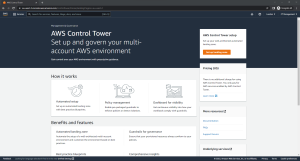
- Click Set up landing zone
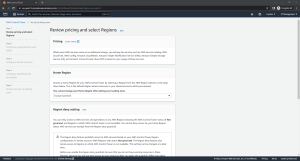
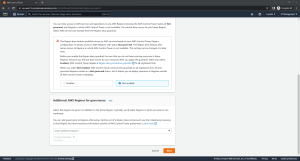
- On the Review pricing and select Regions page, ensure that the Home Region is set to the region that you want.
- Under the Region deny settings section, click Not enabled. If you wish to change this setting later, it can be easily modified.
- Under the Additional AWS Regions for governance section, leave it as it is for the time being. If you wish to add additional regions to be governed later, it can be easily modified.
- Click Next
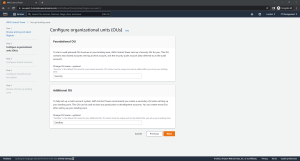
- On the Configure organisational units (OUs) page, click Next.
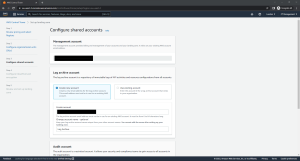
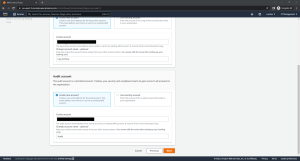
- On the Configure shared accounts page, Under the Log archive account and Audit account sections enter the corresponding e-mail addresses that you created as a pre-requisite for the deployment and then Click Next.
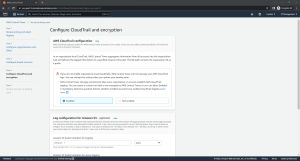
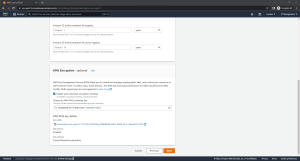
- On the Configure CloudTrail and encryption page; under the AWS CloudTrail configuration section, ensure that its set to Enabled.
- Under the Log configuration for Amazon S3 section, configure the retention policy as per your requirements.
- Under the KMS Encryption section, select Enable and customise encryption settings and then click Create a KMS Key.
This will now open a new browser tab and start the process of creating a Customer Managed Key.
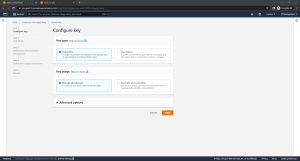
- On the Configure key page, click Next.
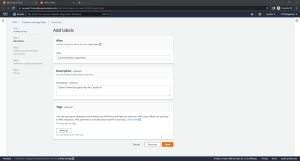
- On the Add labels page; under the Alias section, enter an Alias for the CMK. In this case ControlTowerEncryptionKey has been used.
- Under the Description section, enter a description. In this Control Tower Encryption Key for CloudTrail has been used.
- Click Next.
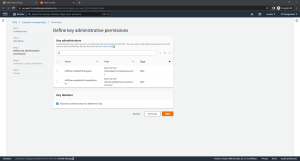
- On the Define key administrative permissions page, click Next.

- On the Define key usage permissions page, click Next.
- On the Review page, click Finish.
Switch back to the browser tab with the Control Tower Setup.
- Under the KMS Encryption section, select the KMS CMK that was just created and then click Next.
- On the Review and set up landing zone page, review the configuration settings and click Set up landing zone.
Control Tower will then start the process of setting up the Landing Zone and will take approximately 30-45 minutes.
Coming up…
Part 2 of this AWS Control Tower walk-through will continue with the initial post-deployment activities within Control Tower including Organisations and Guardrails.
About the author:
Adam Divall, Solutions Architect at GlobalLogic with over 20 years demonstrable experience in design, implementation, migration and support of large, complex solutions to support a customer’s long term business strategy. Divall holds all 12 available certifications for Amazon Web Services with specialisations including Networking, Security, Database, Data Analytics and Machine Learning.
Top Insights
Manchester City Scores Big with GlobalLogic
AI and MLBig Data & AnalyticsCloudDigital TransformationExperience DesignMobilitySecurityMediaTwitter users urged to trigger SARs against energy...
Big Data & AnalyticsDigital TransformationInnovationRetail After COVID-19: How Innovation is Powering the...
Digital TransformationInsightsConsumer and RetailTop Insights Categories

Let’s Work Together
Related Content
GenAI in Action: Lessons from Industry Leaders on Driving Real ROI
Generative AI (GenAI) has the potential to transform industries, yet many companies are still struggling to move from experimentation to real business impact. The hype is everywhere, but the real challenge is figuring out where AI can drive measurable value—and how to overcome the barriers to adoption. In the latest episode of Hitachi ActionTalks: GenAI, … Continue reading Deploying a Landing Zone with AWS Control Tower – Part 1 →
Learn More
Accelerating Digital Transformation with Structured AI Outputs
Enterprises increasingly rely on large language models (LLMs) to derive insights, automate processes, and improve decision-making. However, there are two significant challenges to the use of LLMs: transforming structured and semi-structured data into suitable formats for LLM prompts and converting LLM outputs back into forms that integrate with enterprise systems. OpenAI's recent introduction of structured … Continue reading Deploying a Landing Zone with AWS Control Tower – Part 1 →
Learn More
If You Build Products, You Should Be Using Digital Twins
Digital twin technology is one of the fastest growing concepts of Industry 4.0. In the simplest terms, a digital twin is a virtual replica of a real-world object that is run in a simulation environment to test its performance and efficacy
Learn More
Accelerating Enterprise Value with AI
As many organizations are continuing to navigate the chasm between AI/GenAI pilots and enterprise deployment, Hitachi is already making significant strides. In this article, GlobaLogic discusses the importance of grounding any AI/GenAI initiative in three core principles: 1) thoughtful consideration of enterprise objectives and desired outcomes; 2) the selection and/or development of AI systems that are purpose-built for an organization’s industry, its existing technology, and its data; and 3) an intrinsic commitment to responsible AI. The article will explain how Hitachi is addressing those principles with the Hitachi GenAI Platform-of-Platforms. GlobalLogic has architected this enterprise-grade solution to enable responsible, reliable, and reusable AI that unlocks a high level of operational and technical agility. It's a modular solution that GlobalLogic can use to rapidly build solutions for enterprises across industries as they use AI/GenAI to pursue new revenue streams, greater operational efficiency, and higher workforce productivity.
Learn More
Share this page:
-
-
-
-
URL copied!